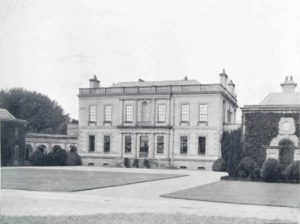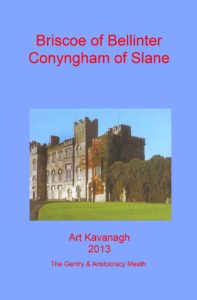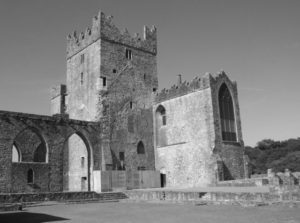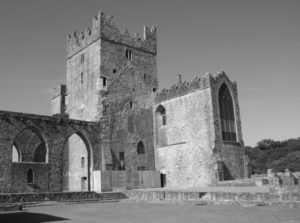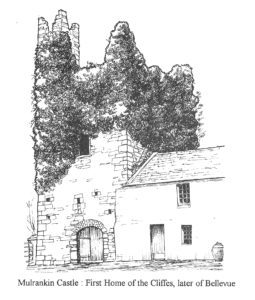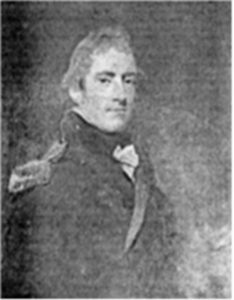de Montmorency of Co. Kilkenny
One of the most extraordinary characters of the ‘old’ family of the Morres/de Montmorency must surely have been Hervey Morres who was born c.1743. He was the son of Hervey the 1st Viscount and his mother was a daughter of Brabazon Ponsonby the 1st Earl of Bessborough. Politics was in his blood from both sides as his father had been an M.P. for many years and the parliamentary exploits of the Ponsonbys are legendary. John Ponsonby, the Speaker, was his uncle. Hervey was educated at Oxford and entered politics shortly afterwards. He was a strong Ponsonby supporter. Some quite amusing stories are told of him. One, in particular, concerned his duel with the Hon. Francis Hely Hutchinson. The cause of the quarrel has been quite forgotten, as so often happens with quarrels, but the duel did place at Donnybrook, in Dublin, a favourite venue for ‘Affairs of Honour’. After taking their places the order to fire was given and Hutchinson was fastest with his shot. de Montmorency fell to the ground but after some time was able to rise to his feet. The protagonists bowed to each other and de Montmorency, helped by his second, was brought to his lodgings in Dublin.
Click HERE for access to the printed book.
de Burgh of Co. Kildare
The de Burghs claim descent from Charlemagne through Jean, Comte de Konign and Baron de Tonsburgh in the late 10th century. Amongst their more prestigious forbears were Baldwin de Burgh, King of Jerusalem (1118 – 1131) and Ode, Bishop of Bayeux, for whom the Bayeux Tapestry was made. The first of the family to settle in Ireland was William de Burgh, a steward of Henry II, who personally received the submission of the Kings of Connaught and Meath at Athlone in 1172. In return he was made Governor of Wexford and “Dominus” or Lord of Connaught by Prince John, Lord of Ireland. Tradition states the de Burgh arms were granted when one of the family killed a leading Saracen while fighting alongside Richard the Lionheart. The crusading monarch is said to have dipped his sword in the dead man’s blood and made the shape of a cross over his fallen shield, saying “these, Knight, be thine arms forever”. As William was married to Richard’s daughter Isabel, widow of Prince Llewelyn of Wales, it seems plausible that he was the man to whom the arms were first granted.
Damer of Tipperary
Of all the Gentry families that ever settled in Tipperary the Damers were the only ones to become part of the folklore, not alone of Tipperary but of many parts of Ireland. The old saying ‘as rich as Damer’ is based on a long tradition concerning the great wealth which was amassed by Joseph Damer.
Joseph Damer was born in Dorset in England in 1630. He became a captain in the Parliamentary Army and came to know Oliver Cromwell. According to some writers he was made a special envoy whose duty it was to liaise with Cardinal Mazarin of France. The story goes that it was at this point in his career that he developed an overriding passion for accumulating wealth, following the example of Mazarin. The good Cardinal was so acquisitive that he was said to be worth over twelve million pounds (sterling we presume) when he died.
Click HERE for further information.
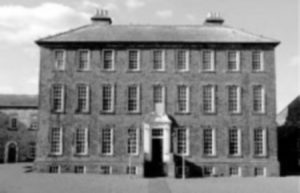
Damer Hall
Cuffe of Co. Kilkenny
In 1641, Hugh Cuffe’s grandson, the Ennis-born Joseph Cuffe, joined a cavalry regiment raised to defend the interests of the new planters during what would become one of the most brutal wars in Irish history. During Oliver Cromwell’s Protectorate, Sir Charles Coote, a first cousin of Joseph, became one of the most powerful men in Ireland. Another close family friend was Sir William Petty, the man entrusted with the redistribution of lands confiscated from Catholic Irish families to English officers. In 1654, Joseph Cuffe was awarded a substantial 5000 acre estate in the barony of Shillelogher, County Kilkenny. In due course his descendents would come to call the estate “Desart”. When a serious challenge to the Cromwellian land settlement was initiated by the administration of the Catholic James II, Agmondesham Cuffe, Joseph’s son and heir, was amongst the first men to take up his sword for the Dutch Prince William of Orange.
Click HERE for further information.

Desart Court
Corballis of Co. Meath
The Corballis family was remarkable for a number of different reasons: they were substantial Catholic landowners prior to the period of the Williamite Wars; their entire property was forfeited after the defeat of the Jacobites and during the period of the worst of the Penal Laws; within a century they had managed to claw their way back financially and socially, while still retaining the religion of their forefathers.
The ancestor of the Corballis family appears to have been a Thomas Corbally from Dunshaughlin who married Ann Woodtown of Nuttstown in 1571.[1] It would seem that his wife brought a dowry of several farms of land in Jordanstown, Nuttstown and Palmerstown. These farms were given to three sons Simon[2], Robert and Philip.
In 1690 Robert Corballis of Nuttstown, a Catholic, sided with King James II and fought at the Battle of the Boyne and was present at the capture of Trim. He was executed in 1694. He had two children who were made wards of the Preston family of Gormanston.
[1] Fiants of Edward VI 1550 John de la Hyde got a grant of lands in the Dunshauglin area some of which were occupied by Thomas Corbally.
[2] Simon’s descendants became Protestant and prospered. They bought Rathbeale House in Swords and were instrumental in founding the committee that started the Fairyhouse Races. Members of this family married into such families as the Nettervilles, Gormanstons and that of Lord Mowbaly – Danny Parkinson in The Corballis Family of Nuttstown
Click HERE for further information.
Conyngham of Co. Meath
Few Irish towns have quite such a beautiful lead in as the estate village of Slane, now one of the most “driven-thru” towns on the main Dublin – Navan Road. As you round the corner from the Dublin Road, Slane rises up in front of you on the opposite banks of the River Boyne. It is said that the road from Dublin to Slane was built for the visit of King George IV to Slane in the early 1820s.
Because of the huge ‘rock’ concerts Slane has become a household word in Ireland and further afield as has the name of Lord Henry Mount Charles, the eldest son of the present Conyngham owner of the Castle and estate the 7th Marquess Conyngham.
Click HERE to access the printed book.

Colclough of Co. Wexford
The Colcloughs were descended from a very ancient and noble family of Staffordshire, whose descendant Sir Anthony Colclough came to Ireland during the reign of King Henry VIII. He was a beneficiary of the policy of Monastic Dissolution. He was granted the estate lands and Manor of Tintern in 1565, by the order of Queen Elizabeth.
He took up residence in Tintern and took possession of the vast estates. He married Clare, the daughter of Sir Thomas Agard, a Privy Councillor in Ireland and Governor of Wexford. They had seven sons, five of whom died young[1], and five daughters[2], one of whom died in infancy.
The two remaining Sons were Thomas the elder son and heir, and Leonard of Ballyknockan, Queen’s County, who was High Sheriff of Wexford in 1596.
Leonard married Honora Walsh daughter of Walter Walsh, Lord of the Mountains, of Co. Kilkenny. Leonard was killed in a battle with the O’Byrnes of Wicklow in 1599 and left a son, Anthony of Old Ross, whose two sons died without having married.
[1] The third son Anthony was killed fighting in 1598 in the Nine Years War
[2] Jaquet m. Sir Nicholas Walsh, Frances m. William Smethwicke, Mary m. John Cots of Salop and Clara m. William Sneyd
Click HERE for further information.

Tintern Abbey
Colclough of Co. Wexford
The Colcloughs were descended from a very ancient and noble family of Staffordshire, whose descendant Sir Anthony Colclough came to Ireland during the reign of King Henry VIII. He was a beneficiary of the policy of Monastic Dissolution. He was granted the estate lands and Manor of Tintern in 1565, by the order of Queen Elizabeth.
He took up residence in Tintern and took possession of the vast estates. He married Clare, the daughter of Sir Thomas Agard, a Privy Councillor in Ireland and Governor of Wexford. They had seven sons, five of whom died young[1], and five daughters[2], one of whom died in infancy.
The two remaining Sons were Thomas the elder son and heir, and Leonard of Ballyknockan, Queen’s County, who was High Sheriff of Wexford in 1596.
[1] The third son Anthony was killed fighting in 1598 in the Nine Years War
[2] Jaquet m. Sir Nicholas Walsh, Frances m. William Smethwicke, Mary m. John Cots of Salop and Clara m. William Sneyd
Click HERE to buy this book.

Cliffe of Co. Wexford
The first of the Cliffe family to come to Ireland was John Cliffe, Secretary of War in the Army of Cromwell. He acquired grants of land in Wexford and Meath. In Wexford the Mulrankin estates of the Brownes were granted to William Ivory, John Annsloe and John Cliffe, but it was Cliffe who eventually acquired the whole estate, because of his exalted position as Secretary to General Henry Ireton, Cromell’s Deputy and son in law.
An M.P. for the borough of Taghmon, he was appointed High Sheriff of Wexford in 1680. He was married to Eleanor the 5th daughter of Nicholas Loftus of Fethard, Co. Wexford the grandfather of the first Lord Loftus of Loftus Hall.
Click HERE for further information.

Clements of Kildare & Leitrim
In the mid 17th century, a Leicestershire family emigrated to Massachusetts and so escaped the ravages of the English Civil War. Only one son, Daniel Clements, remained behind, serving a commission in the army of Oliver Cromwell. For his military services in Ireland he was rewarded with an estate in Cavan. His descendents rapidly scaled the heights of the Anglo-Irish ascendancy gaining the Earldom of Leitrim in 1795. Meanwhile, in America, Daniel’s sister Mary was arrested for witchcraft during the Salem Witch Trials. Daniel’s grandson Nat Clements was one of the great amateur architects of Georgian Ireland. Perhaps his best-known legacy is the Irish President’s residence, Arás an Uachtaráin, in the Phoenix Park.
Click HERE to access the printed book.

Nat Clements

